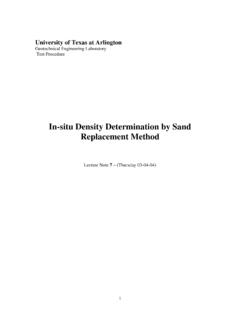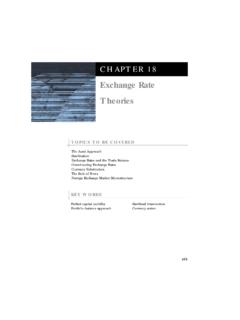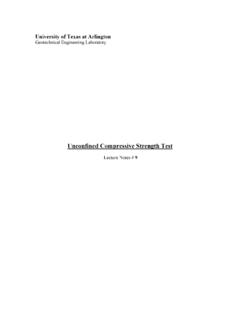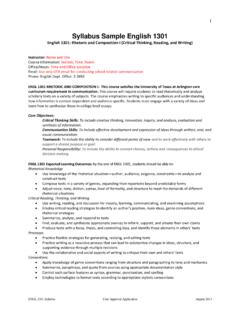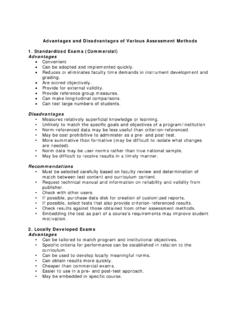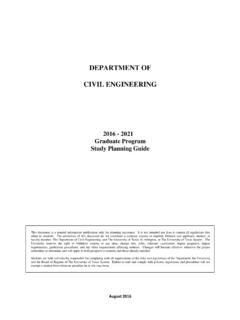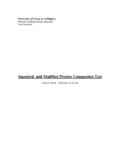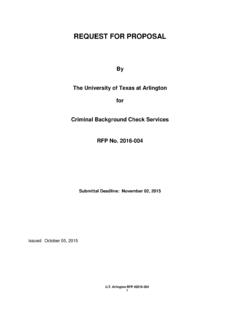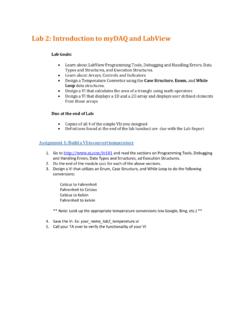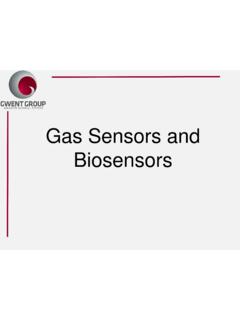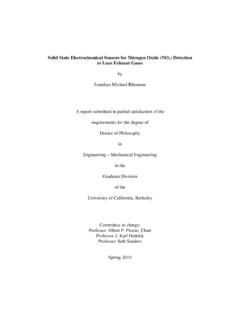Transcription of Chemical sensors for portable, handheld field instruments ...
1 256 IEEE sensors JOURNAL, VOL. 1, NO. 4, DECEMBER 2001 Chemical sensors for portable , handheld FieldInstrumentsDenise Michele Wilson, Member, IEEE, Sean Hoyt, Jiri Janata, Karl Booksh, and Louis ObandoAbstract A review of three commonly used classes of chemicalsensor technologies as applicable to implementation in portable , handheld field instruments is presented. solid -state gas and chem-ical sensors have long been heralded as the solution to a wide va-riety of portable Chemical sensing system applications. However,advances in optical sensing technology have reduced the size of sup-porting infrastructure to be competitive with their solid -state coun-terparts. Optical, solid -state, and hybrid arrays of sensors haveapplication for portable instruments , but issues of insufficient se-lectivity and sensitivity continue to hamper the widespread intro-duction of these miniaturized sensors for solving Chemical sensingproblems in environments outside the laboratory.
2 In this article,we evaluate three of the major classes of compact Chemical sen-sors for portable applications: ( solid -state) chemiresistors, ( solid -state) CHEMFETs, and (optical) surface plasmon resonance sen-sors (SPR). These sensors are evaluated and reviewed, accordingto the current state of research, in terms of their ability to operateat low-power, small-size, and relatively low-cost in environments,with numerous interferents and variable ambient Terms CHEMFET, Chemical sensors , chemiresistors,conducting polymer sensors , gas sensor , ISFET, metal oxidesensors, surface plasmon resonance (SPR).I. INTRODUCTIONMINIATURIZED Chemical sensors have yet to achievetheir full potential for commercialization. The reasonsfor this delay in widespread commercialization are , insufficiently robust selectivity and sensitivityof Chemical sensor technologies after miniaturization are acommon limitation to the progressive development of chemicalsensors toward handheld commercial products.
3 For portablefield-based instruments , high noise levels in the chemicalcomposition of the field environment as well as the potentialimpact of highly variable ambient conditions have a profoundeffect on the noise level which Chemical sensor technologiesmust accommodate while producing a robust and reliableoutput signal. Unlike imaging (visual sensing) technologieswhere only one type of light ( , infrared or visible range)is detected and sound (auditory sensing) technologies whereonly one type of pressure wave is detected, Chemical sensorsmust transduce a variety of input stimuli using a variety ofManuscript received September 18, 2000; revised October 17, 2001. The as-sociate editor coordinating the review of this paper and approving it for publi-cation was Prof. Julian W. M. Wilson and S. Hoyt are with the Department of Electrical Engi-neering, University of Washington, Seattle, WA 98195-2500 USA Janata is with the Department of Chemistry, Georgia Institute of Tech-nology, Atlanta, GA 30332 Booksh and L.
4 Obando are with the Department of Chemistry and Bio-chemistry, Arizona State University, Tempe, AZ 85287-1604 Item Identifier S 1530-437X(01) mechanisms or reactions. This broad range ofstimuli and transduction mechanisms is a result of both aninherent characteristic of most Chemical sensor technologiesand an engineered characteristic that is used to produce a signalrepresenting the stimulus of interest significantly stronger thanthose of interfering is a term often used to refer either to the lowestlevel of Chemical concentration that can be detected or to thesmallest increment of concentration that can be detected inthe sensing environment. In typical laboratory applications forchemical sensing, it is necessary to know exactly how muchof each Chemical component is present in a complex mixtureacross a wide dynamic range. In many portable chemicalsensing applications, however, such as landmine detection,environmental (ground water and air pollution) monitoring,and toxic Chemical agent detection, it is necessary only toknow when the concentration of a single or small numberof chemicals has exceeded certain alarm levels.
5 This changein focus from complex composition analysis to alarm leveldetection changes the requirements of the sensing system. Inthe laboratory applications, both sensitivity associated withdynamic range and resolution as well as sensitivity associatedwith the lower detection limit are important. In many portableapplications, however, the lower detection limit, rather thanresolution or dynamic range becomes a dominant factor indetermining the usefulness of a Chemical sensor is worth noting that many concentration limits dictatedby Chemical sensor applications in the field are extremelylow, well beyond the capability of the human nose to detectand approaching or exceeding the capability of the caninenose to detect as well. Engineering systems to achieve thesestringent concentration detection limits require mature andwell-understood science in the Chemical sensor technologyas well as the elegant and creative design of measurementand signal processing surrounding these sensor , miniaturization of sensor technologies in the designof the portable instrument can often sacrifice some of thedynamic range and resolution of the sensor , but must not causesignificant increase in noise levels and hence degradation ofthe detection threshold.
6 Unfortunately, miniaturization oftengenerates an increase in noise, thereby necessitating furtherstringency in the remainder of the design parameters, includingprecise control of manufacturing variations and micro andnanoscale characteristics of these selectivity does not typically suffer adverse degrada-tion upon miniaturization but nevertheless presents many bar-riers in tailoring Chemical sensing technologies to particular ap-plications. Selectivity refers to the ratio of the sensor s ability1530 437X/01$ 2001 IEEEWILSONet al.: Chemical sensors FOR portable , handheld field INSTRUMENTS257to detect what is of interest over the sensor s ability to detectwhat is not of interest (the interferents). For the detection ofonly a single type of molecule, the ideal Chemical sensor selec-tivity is infinity, reacting only to the one molecule of interest andtransducing it into an electrical signal that contains no funda-mental noise from environmental interferents.
7 For the detectionof multiple types of single molecules, the ideal Chemical sensorsystem contains an array of sensors , each infinitely selective toone type of molecule. For the detection of complex mixtures ofmolecules, the ideal Chemical sensor system is not as easily de-fined and depends on a wide variety of parameters, not the leastof which is the composition and range of Chemical variations inthe ambient environment. Even in relatively simple applica-tions, such as the detection of a single molecule, the ideal chem-ical sensor is typically not available. Selectivity then, is oftentailored and adjusted to the analyte(s) of interest by varying awide range of parameters including dopants, grain sizes, cat-alysts, external filters, operating temperature, and many otherfactors. Miniaturization of the Chemical sensor technology forportable applications often involves examination of new sensortechnologies as many macroscale technologies cannot be scaledto miniaturized technologies using the same fabrication pro-cesses.
8 After a shift in fabrication processes, the tunability ofthe selectivity to certain chemicals is often re-examined to es-tablish optimal ways to achieve selectivity under the constraintsof the fabrication process. This re-evaluation is often not ac-complished elegantly, since the quickest conversion to minia-turized sensors is often done by scaling down the macroscaleprocesses and design methodologies. After this direct path tominiaturization is accomplished and found to be wanting, then,engineers and scientists turn to the redesign of the sensor process can be slow, especially due to the complexity oftransduction mechanisms that must be considered with everychemical sensor technology and its associated parameter vari-ations for tuning selectivity both at macro and , unlike other sensing technologies such as those as-sociated with visual sensing (imagers), commercial, miniatur-ized Chemical sensing products are out of the question until acertain stringent level of precision (sensitivity and selectivity)is achieved with the component Chemical sensor the miniaturized visual imagers (CCD and CMOS)were commercialized first at low resolutions and progressed tohigher resolutions in subsequent generations of products, mostminiaturized Chemical sensor technologies have not had thisluxury.
9 This inability to use existing, manufacturing-scale fabri-cation processes to evolve subsequent generations of higher res-olution, sensitivity, and selectivity Chemical sensor products is aprofound limitation to the commercialization of portable chem-ical sensing systems. With this limitation in mind, it is perhapseasier to understand the (relatively) slow evolution in miniatur-ization of Chemical sensor those applications where Chemical sensor technologieshave been available for portable instrument development,robustness has been the last major stumbling block towardcommercial product development. Robustness, at the sensorlevel, refers to the ability of the sensor to perform its functionover a range of ambient conditions ( , humidity, temperature,etc.) and over a range of times in the presence of drift andstability variations. Unfortunately, the parameters of a chemicalsensor technology that can be adjusted to improve robustnessare often the same parameters that result in a decrease in sensi-tivity and selectivity.
10 For example, the most sensitive chemicalsensor is often one whose reactions are totally irreversible; inthis situation, every reaction with every molecule of interestin the environment is captured and can be measured, naturallyleading to maximum sensitivity; in semi-reversible sensors ,the kinetic balance between outgoing transduction eventsand incoming transduction events relevant to measuring thestimulus of interest inherently results in reduced sensitivityover the sensor whose reactions are completely irreversible. Asimilar design dilemma occurs when increasing the sensitivityof a Chemical sensor improves the response to the stimulusof interest but also, frequently increases the sensitivity of thechemical sensor to interferents ( , noise in the ambientenvironment). Achieving a fine balance between robustness andsystem sensitivity ( , performance to design specifications)is a delicate effort involving both engineering and this balance can be achieved, it involves engineeringdesign methodologies and scientific optimization of chemicalsensors that must cross disciplines in a coherent, methodical,and efficient manner.
